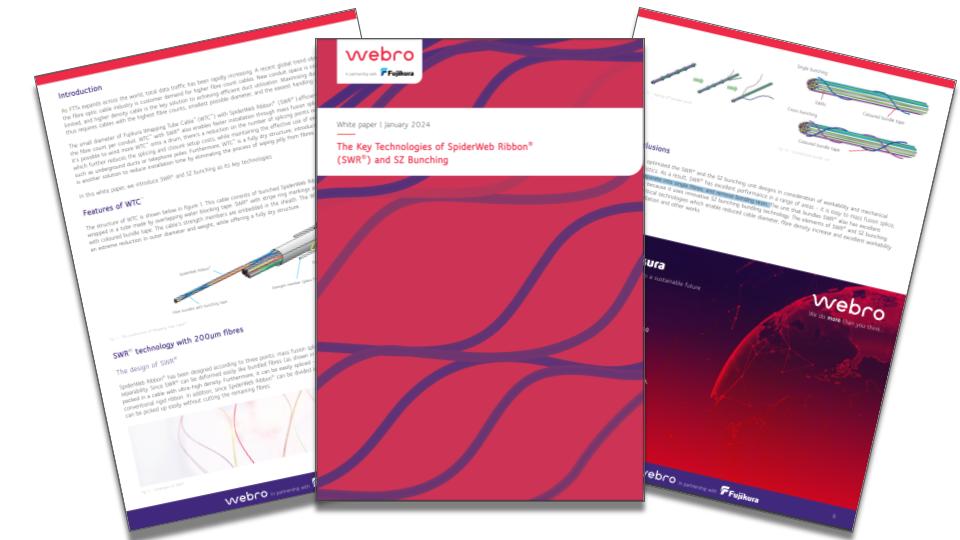As we generate more data, network operators are striving to increase capacity to meet the demands of businesses and communities across the UK and Europe. The specific discussion surrounding ribbon fibre cable is one about efficient and cost-effective optical network deployment and management. This is where Fujikura Wrapping Tube Cable (WTC) with SpiderWeb Ribbon (SWR) Fibre steps in.
WTC with SWR is an innovative ribboned optical fibre product. It has a fully dry central core cable which enables 12-fibre mass fusion splicing, and drastically reduces cable diameter and weight. Ribbon fibre facilitates the simultaneous splicing of 12 fibres, which reduces installation time significantly by up to 72% versus the traditional practice of splicing individual fibres. It’s easy to see why the product is enabling some of Europe’s biggest network operators to expand their networks and meet the demands of an increasingly digital future. The structured ribbon configuration makes them a valuable solution for high-capacity telecommunications networks, data centres, rail, and mass transit networks, along with other environments where space optimisation and efficient fibre management is crucial.
Specifically, there are five key reasons why WTC with SWR is a game changer…
#1 Industry-leading fibre density means more effective use of duct space
Optimising duct space is vital. The unique construction of WTC with SWR enables customers to get more fibres in their cables. Empowered with increased fibre density, they’re able to place more fibres into the available duct space.
By contrast, traditional loose tube cables use a strength member that runs through the centre of the cable, which is surrounded by different tubes containing individual fibres. This design results in sizable dead space in the cable. The WTC with SWR design is superior because the strength members are inside the cable, and the cable interior is packed full of fibres that use all of the available space.
Demonstrating this superiority, a 1728-fibre Fujikura Wrapping Tube Cable is 37% smaller than a 1728-fibre conventional ribbon loose tube cable, and 65% lighter. This results in the optimum use of duct and manhole space, which are often congested with legacy cables - especially in larger, older cities.

#2 Cost of ownership is reduced
It takes less time to splice WTC with SWR. With SWR you can splice 12 fibres at once using a mass fusion splicer (e.g. Fujikura 90R), as opposed to undertaking hundreds of individual fibre splices. Field studies have shown that splicing together two 432-fibre to 432-fibre loose tube joints is a job that can take 41 hours of preparation and splicing time on average. By contrast, the same task using WTC with SWR cable would take approximately eight hours.
Because WTC with SWR enables work to be carried out 8 to 12 times faster than traditional loose tube fibre, the total cost of ownership requires less man hours. This is a significant benefit to customers in the current climate, where rising labour costs and difficulty securing sufficiently skilled labour to complete the work are both major challenges.
#3 Deployments are sped up
To access the fibre and begin splicing with traditional loose tube cable the binding yarns have to be cut, the tubes must be unwound from the CSM, and each tube has to be cut and removed. Traditional loose tube cable also contains a jelly to keep it watertight, which has to be removed from the fibres using alcohol wipes and further extends preparation time. Overall, it’s a messy, time-consuming process.
By contrast, the ease of splicing SWR fibre – especially with the dedicated Fujikura 90R splicer, is a powerful benefit, and it’s complemented by the dry construction of WTC. Because it uses a water blocking tape to keep moisture out it’s free from jelly and doesn’t contain binding yarns or tubes, so accessing the fibres is quick, easy, and simple.
#4 Manpower efficiencies are optimised
One engineer working on a single job for a whole week using traditional loose tube cable could reduce the time to get the job done to just one day by using Fujikura WTC™ with SWR. This is hugely beneficial to network operators who organise teams of engineers as they prosper from increased labour capacity. With combined faster deployments, the increased flex in the workforce frees them up to both deal with repairs and to move on to new jobs sooner. Furthermore, self-employed engineers gain because with jobs taking less time, they get more opportunity to find work, plan work, and administer their business. They also gain credibility by building a reputation for being a faster installer.
#5 WTC with SWR is kind to equipment
Because Fujikura cable is dry it’s kinder to equipment. There’s less material to get into the splicer and prevent it from working, whereas the jelly in traditional cables picks up dirt that inevitably finds its way inside splicers and strippers and results in them needing to be taken apart and cleaned. Fujikura WTC with SWR is clean to start with, and that property remains.

In summary
The significance of ribbon fibre cable can’t be overstated in the fast-evolving fibre optics sector. At the forefront of technological development, Fujikura has delivered an innovative solution that enhances installations, drives efficiency, and increases speed.
Fujikura WTC with SWR is spearheading a future where installation times are reduced by an impressive 72%. The meticulously organised ribbon structure holds the key to unlocking unparalleled fibre density and streamlined installations. From FTTH connections and data centres to rail and mass transit communications, Fujikura WTC with SWR is a cornerstone asset in project environments which prioritises fibre management and the optimum use of space.
As technology advances and our world becomes increasingly interconnected, Fujikura's WTC with SWR fibre cable solution will continue to boost efficiency, reliability, and innovation across the modern communications infrastructure.
More information
Need technical help & advice to choose the right cable for your project? Talk to the dedicated Webro Team for expert advice: sales@webro.com | 0115 972 4483 | www.webro.com. You can also find more information about how to maximise your network's efficiency using Fujikura's SWR cable and SZ Bunching by downloading the latest White Paper from Webro, in partnership with Fujikura.
Wrapping Tube Cable (WTC) and SpiderWeb Ribbon (SWR) Fibre are registered trademarks of Fujikura.



